Development of a Scanning Protocol for Anthropological Remains: A Preliminary Study
Abstract
1. Introduction
2. Materials and Methods
The Contexts
3. Results
4. Discussion
Author Contributions
Funding
Data Availability Statement
Acknowledgments
Conflicts of Interest
References
- Diara, F. Structured-Light Scanning and Metrological Analysis for Archaeology: Quality Assessment of Artec 3D Solutions for Cuneiform Tablets. Heritage 2023, 6, 6016–6034. [Google Scholar] [CrossRef]
- Kusuma Frisky, A.Z.; Fajri, A.; Brenner, S.; Sablatnig, R. Acquisition Evaluation on Outdoor Scanning for Archaeological Artifact Digitalization. In Proceedings of the VISIGRAPP—15th International Joint Conference on Computer Vision, Imaging and Computer Graphics Theory and Applications, Valletta, Malta, 27–29 February 2020; Farinella, G.M., Radeva, P., Braz, J., Eds.; SciTePress: Setúbal, Portugal, 2020; Volume 5, pp. 792–799. [Google Scholar]
- Menna, F.; Nocerino, E.; Remondino, F.; Dellepiane, M.; Callieri, M.; Scopigno, R. 3D Digitization of an Heritage Masterpiece—A Critical Analysis on Quality Assessment. Int. Arch. Photogramm. Remote Sens. Spat. Inf. Sci. 2016, 41, 675–683. [Google Scholar] [CrossRef]
- Russo, M.; Senatore, L.J. Low-Cost 3d Techniques for Real Sculptural Twins in the Museum Domain. Int. Arch. Photogramm. Remote Sens. Spat. Inf. Sci. 2022, 48, 229–236. [Google Scholar] [CrossRef]
- Maté-González, M.Á.; Aramendi, J.; González-Aguilera, D.; Yravedra, J. Statistical Comparison between Low-Cost Methods for 3D Characterization of Cut-Marks on Bones. Remote Sens. 2017, 9, 873. [Google Scholar] [CrossRef]
- Evgenikou, V.; Georgopoulos, A. Investigating 3D Reconstruction Methods for Small Artifacts. ISPRS-Int. Arch. Photogramm. Remote Sens. Spat. Inf. Sci. 2015, XL-5/W4, 101–108. [Google Scholar] [CrossRef]
- Garashchenko, Y.; Kogan, I.; Rucki, M. Comparative Accuracy Analysis of Triangulated Surface Models of a Fossil Skull Digitized with Various Optic Devices. Metrol. Meas. Syst. 2022, 29, 37–51. [Google Scholar] [CrossRef]
- Merella, M.; Farina, S.; Scaglia, P.; Caneve, G.; Bernardini, G.; Pieri, A.; Collareta, A.; Bianucci, G. Structured-Light 3D Scanning as a Tool for Creating a Digital Collection of Modern and Fossil Cetacean Skeletons (Natural History Museum, University of Pisa). Heritage 2023, 6, 6762–6776. [Google Scholar] [CrossRef]
- Bastir, M.; García-Martínez, D.; Torres-Tamayo, N.; Palancar, C.A.; Fernández-Pérez, F.J.; Riesco-López, A.; Osborne-Márquez, P.; Ávila, M.; López-Gallo, P. Workflows in a Virtual Morphology Lab: 3D Scanning, Measuring, and Printing. J. Anthropol. Sci. 2019, 97, 107–134. [Google Scholar] [CrossRef]
- Georgopoulos, A.; Ioannidis, C.; Valanis, A. Assessing the Performance of a Structured Light Scanner. Int. Arch. Photogramm. Remote Sens. Spat. Inf. Sci. 2010, 38, 251–255. [Google Scholar]
- Morena, S.; Barba, S.; Álvaro-Tordesillas, A. Shining 3D EinScan-Pro, Application and Validation in the Field of Cultural Heritage, from the Chillida-Leku Museum to the Archaeological Museum of Sarno. Int. Arch. Photogramm. Remote Sens. Spat. Inf. Sci. 2019, 42, 135–142. [Google Scholar] [CrossRef]
- Shining 3D EinStar|V-GER SHOP. Available online: https://shop.vger.eu/uncategorized/shining-3d-einstar/ (accessed on 29 June 2024).
- Williams, R.; Thompson, T.; Orr, C.; Taylor, G. Developing a 3D Strategy: Pipelines and Recommendations for 3D Structured Light Scanning of Archaeological Artefacts. Digit. Appl. Archaeol. Cult. Herit. 2024, 33, e00338. [Google Scholar] [CrossRef]
- Dickin, F.; Pollard, S.; Adams, G. Mapping and Correcting the Distortion of 3D Structured Light Scanners. Precis. Eng. 2021, 72, 543–555. [Google Scholar] [CrossRef]
- Colosimo, B.M.; Pacella, M.; Senin, N. Multisensor Data Fusion via Gaussian Process Models for Dimensional and Geometric Verification. Precis. Eng. 2015, 40, 199–213. [Google Scholar] [CrossRef]
- Jacobs, L.; Dvorak, J.; Cornelius, A.; Zameroski, R.; No, T.; Schmitz, T. Structured Light Scanning Artifact-Based Performance Study. Manuf. Lett. 2023, 35, 873–882. [Google Scholar] [CrossRef]
- Gupta, M.; Yin, Q.; Nayar, S.K. Structured Light in Sunlight. In Proceedings of the 2013 IEEE International Conference on Computer Vision, Sydney, Australia, 1–8 December 2013; pp. 545–552. [Google Scholar]
- Profico, A.; Bellucci, L.; Buzi, C.; Di Vincenzo, F.; Micarelli, I.; Strani, F.; Tafuri, M.A.; Manzi, G. Virtual Anthropology and Its Application in Cultural Heritage Studies. Stud. Conserv. 2019, 64, 323–336. [Google Scholar] [CrossRef]
- Errickson, D.; Grueso, I.; Griffith, S.J.; Setchell, J.M.; Thompson, T.J.U.; Thompson, C.E.L.; Gowland, R.L. Towards a Best Practice for the Use of Active Non-Contact Surface Scanning to Record Human Skeletal Remains from Archaeological Contexts. Int. J. Osteoarchaeol. 2017, 27, 650–661. [Google Scholar] [CrossRef]
- Licata, M.; Tesi, C.; Larentis, O.; Destefanis, E.; Garanzini, F.; Ciliberti, R.; Fusco, R. Elongated Styloid Process of an Autopsied Skull from the Cemetery of Santa Maria Maggiore in Vercelli, 18th-19th Century (Piedmont, Northern Italy). Anthropol. Anz. 2024, 81, 209–218. [Google Scholar] [CrossRef] [PubMed]
- Balletti, C.; Bertellini, B.; Gottardi, C.; Guerra, F. Geomatics Techniques for the Enhancement and Preservation of Cultural Heritage. Int. Arch. Photogramm. Remote Sens. Spat. Inf. Sci. 2019, XLII-2/W11, 133–140. [Google Scholar] [CrossRef]
- Luhmann, T.; Robson, S.; Kyle, S.; Boehm, J. Close-Range Photogrammetry and 3D Imaging; De Gruyter: Berlin, Germany; Boston, MA, USA, 2020; ISBN 978-3-11-060725-3. [Google Scholar]
- Mazzucchi, A.; Taglioretti, R.; Marinato, M. MAPOD4D “CSSG”: The First Metaverse on the Skeletal Recovery in the Experimental Field Laboratory for the Research on Technological Applications in the Archaeological UNESCO Site of Castelseprio—San Giovanni. JBR 2024, 2, e2024006. [Google Scholar]
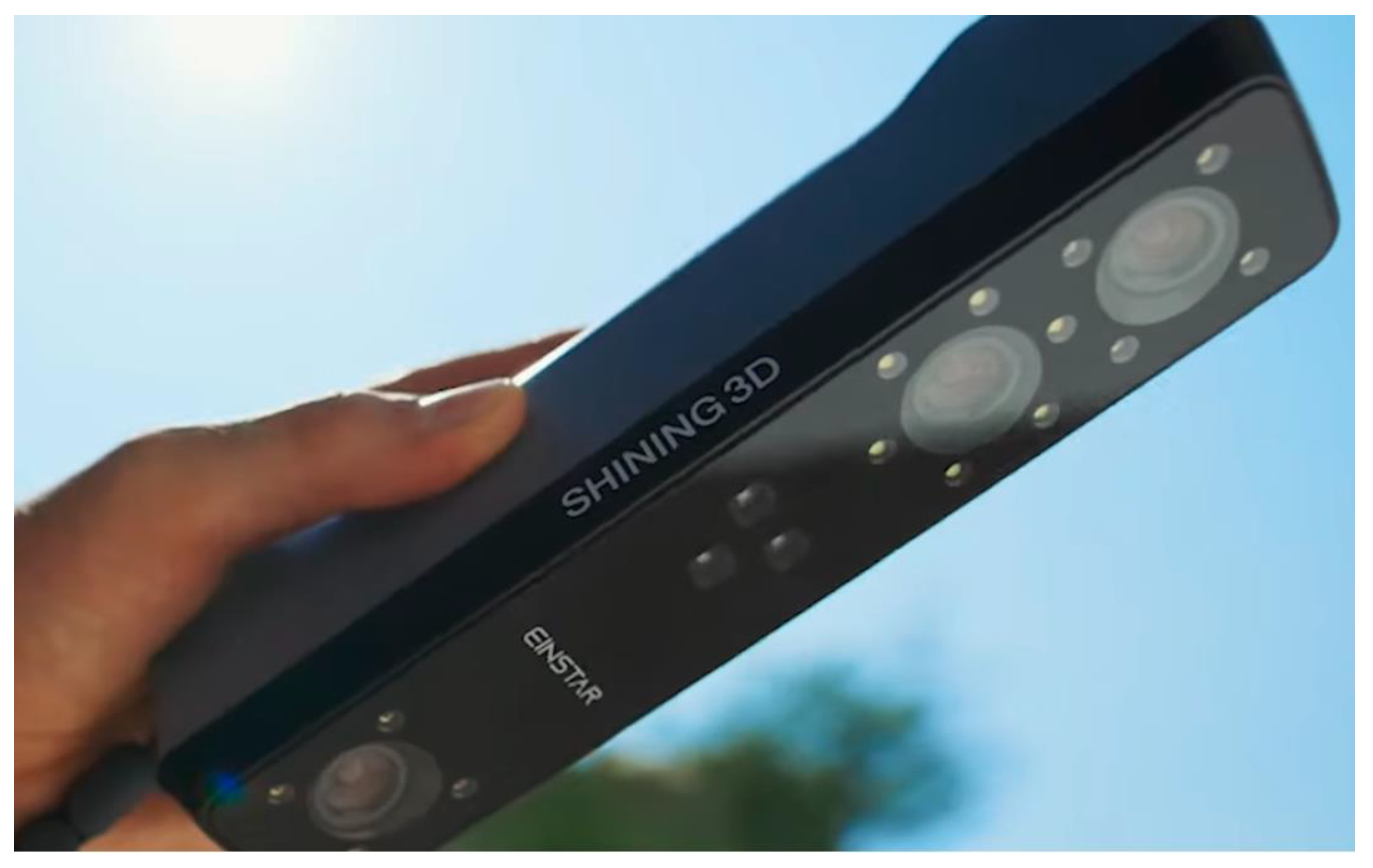
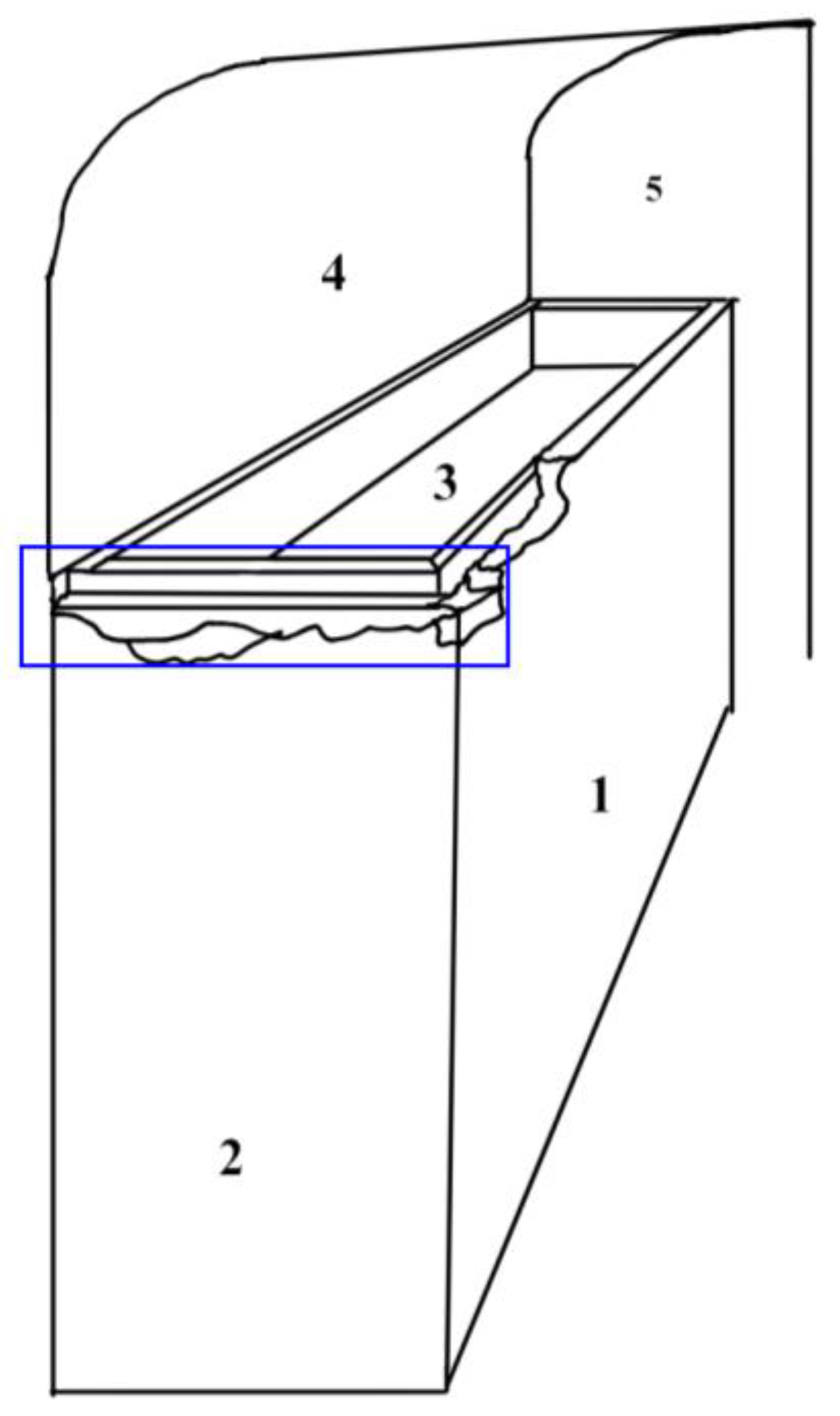
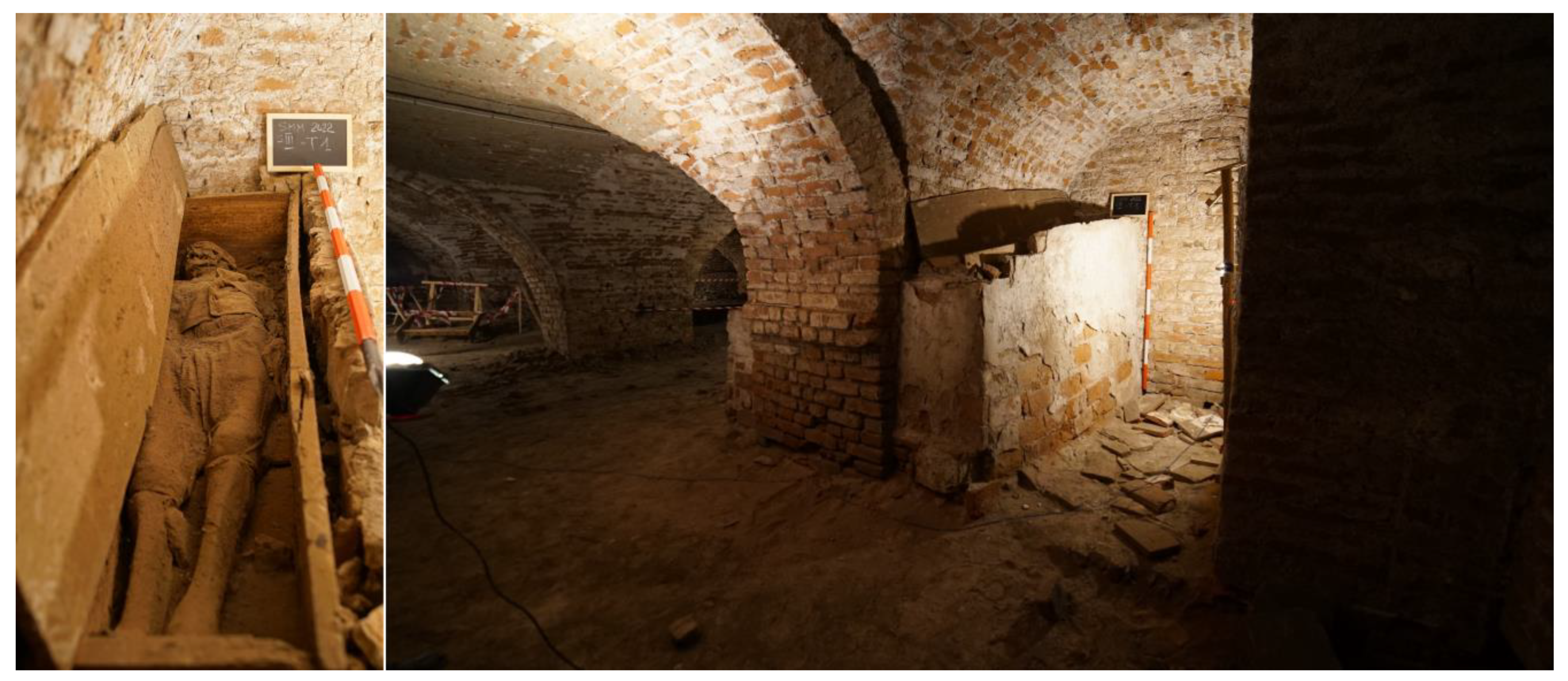
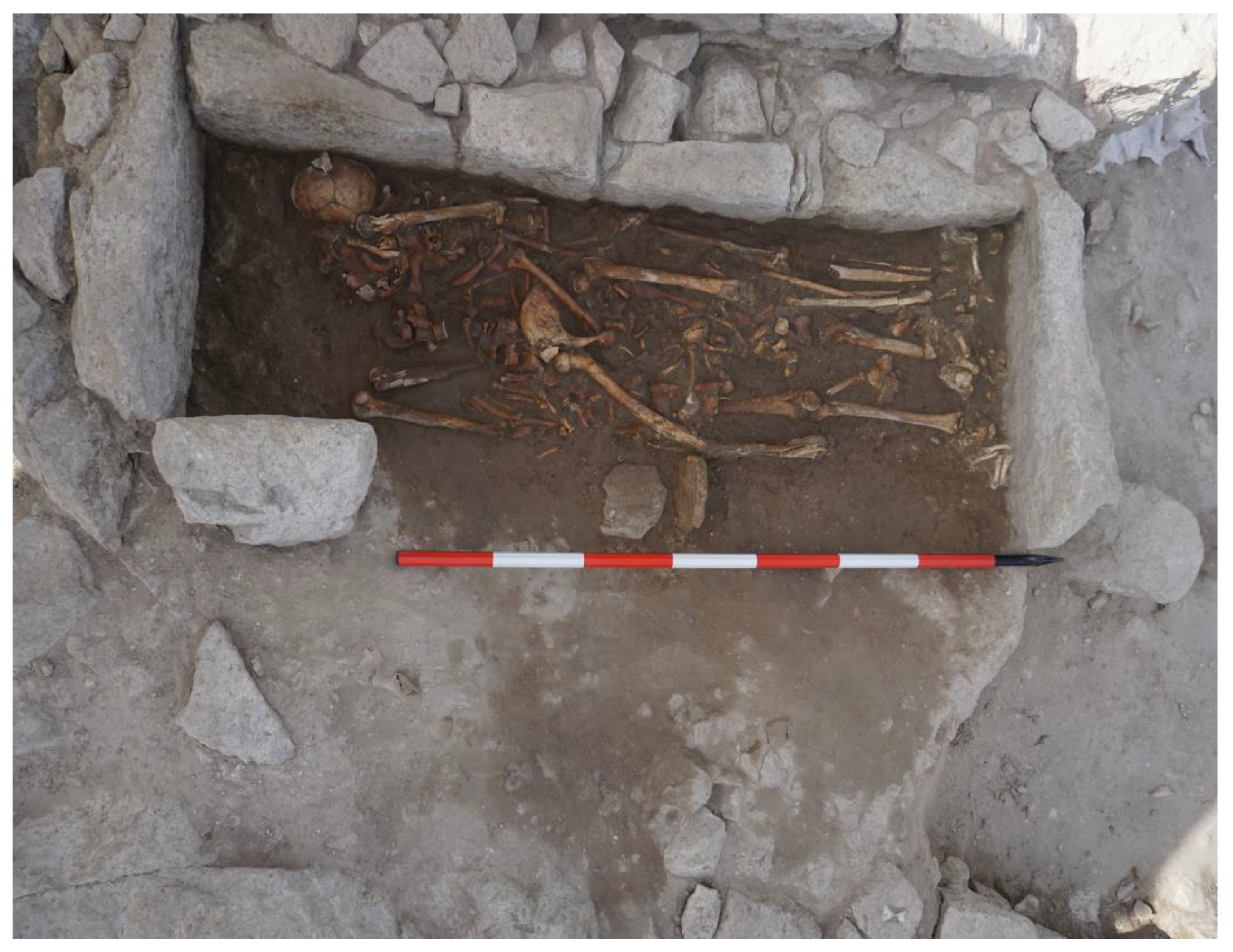
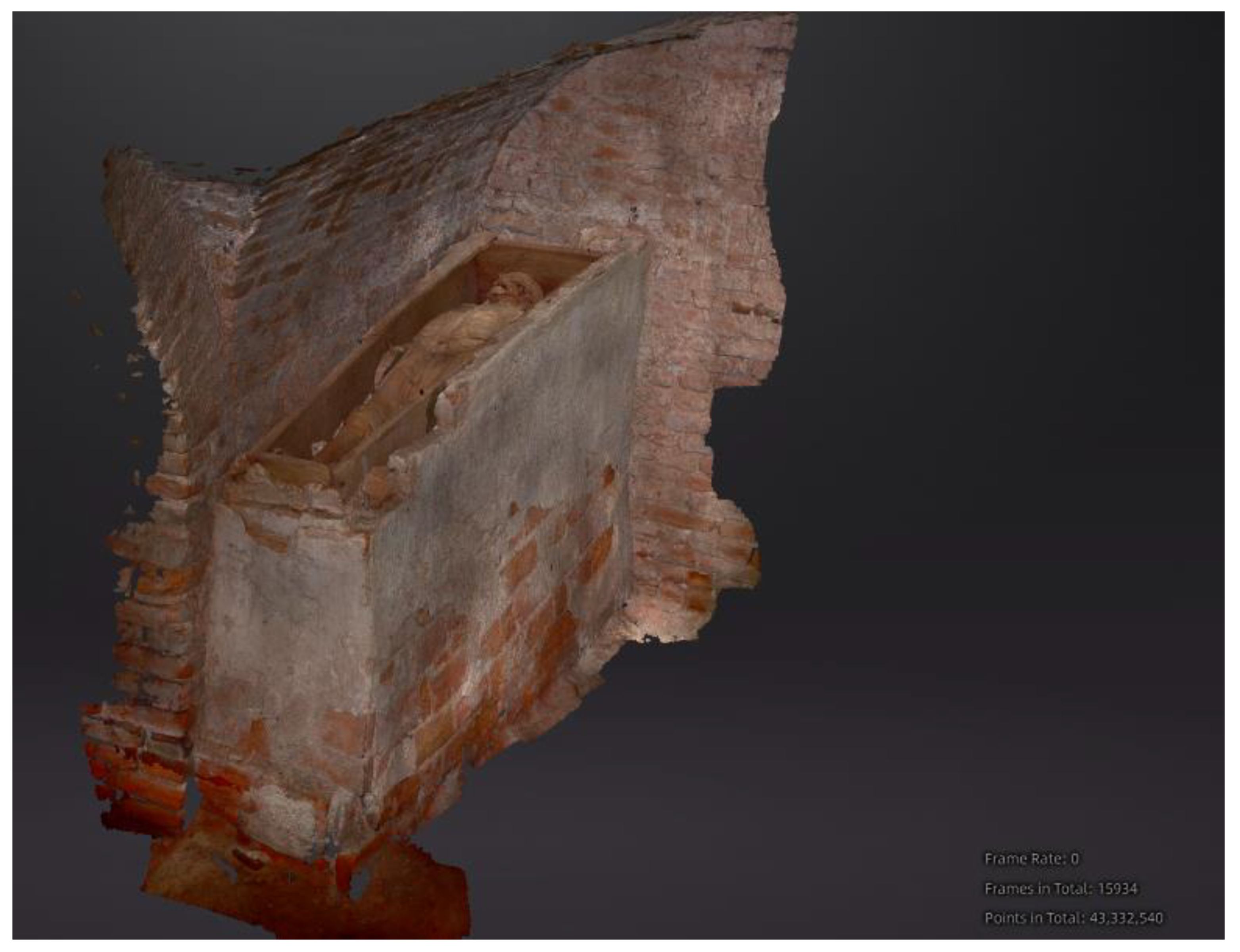

Disclaimer/Publisher’s Note: The statements, opinions and data contained in all publications are solely those of the individual author(s) and contributor(s) and not of MDPI and/or the editor(s). MDPI and/or the editor(s) disclaim responsibility for any injury to people or property resulting from any ideas, methods, instructions or products referred to in the content. |
© 2024 by the authors. Licensee MDPI, Basel, Switzerland. This article is an open access article distributed under the terms and conditions of the Creative Commons Attribution (CC BY) license (https://creativecommons.org/licenses/by/4.0/).
Share and Cite
Orsi, M.; Fusco, R.; Mazzucchi, A.; Taglioretti, R.; Marinato, M.; Licata, M. Development of a Scanning Protocol for Anthropological Remains: A Preliminary Study. Heritage 2024, 7, 4997-5006. https://doi.org/10.3390/heritage7090236
Orsi M, Fusco R, Mazzucchi A, Taglioretti R, Marinato M, Licata M. Development of a Scanning Protocol for Anthropological Remains: A Preliminary Study. Heritage. 2024; 7(9):4997-5006. https://doi.org/10.3390/heritage7090236
Chicago/Turabian StyleOrsi, Matteo, Roberta Fusco, Alessandra Mazzucchi, Roberto Taglioretti, Maurizio Marinato, and Marta Licata. 2024. "Development of a Scanning Protocol for Anthropological Remains: A Preliminary Study" Heritage 7, no. 9: 4997-5006. https://doi.org/10.3390/heritage7090236
APA StyleOrsi, M., Fusco, R., Mazzucchi, A., Taglioretti, R., Marinato, M., & Licata, M. (2024). Development of a Scanning Protocol for Anthropological Remains: A Preliminary Study. Heritage, 7(9), 4997-5006. https://doi.org/10.3390/heritage7090236




